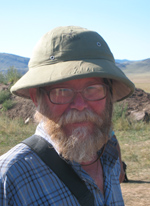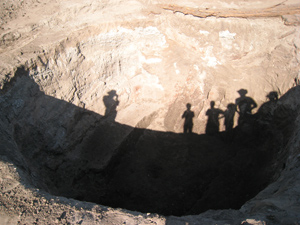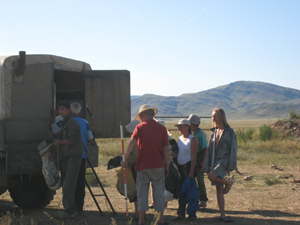 Excavations of an entire chain of royal burials in the Valley of Kings (Pii-Khem district, Tuva), are being conducted by archeologists of Tuvan expedition under the leadership of Candidate of historical sciences Vladimir Semyonov. Excavations of an entire chain of royal burials in the Valley of Kings (Pii-Khem district, Tuva), are being conducted by archeologists of Tuvan expedition under the leadership of Candidate of historical sciences Vladimir Semyonov.
1.5 kilometers from the settlement Arzhaan, the archeologists are finishing up the excavation of an elite kurgan, with preliminary dating of 6th century before our era. “This is a kurgan of Uyuk culture. Very few of them have been excavated so far, - explains Vladimir Semyonov. – It is a burial of a chief. I would not use the word “king”. We can speak of chiefs, but not kings. It was a chiefdom.”
 Archeological excavations in a locality Koshpei, which have been conducted since 1989 by Semyonov’s expedition, have a “rescue” character. The kurgans are situated in an area along the perimeter of a highway, and there is a real threat that they will be destroyed. Archeological excavations in a locality Koshpei, which have been conducted since 1989 by Semyonov’s expedition, have a “rescue” character. The kurgans are situated in an area along the perimeter of a highway, and there is a real threat that they will be destroyed.
“We submitted an application to the federal special program “Culture of Russia” and it was accepted, - explains the leader of the Service of Protection of Monuments of Cultural Heritage, Antonina Dongak. – The work is being done by our experienced archeologists from St. Petersburg. And for already the second season, they are getting help from students from the History Department of TGU, which opened a section of Archeology, Ethnography and Regional Studies”.
Vladimir Semyonov has been working in Tuva for 37 seasons. Last year, his
 book “Pervobytnoye iskusstvo. Kamennyi vek. Bronzovyi vek.”(Primitive Art. Stone Age. Bronze Age.), was published. It encompasses a period of about 35,000 years, from the time of appearance of the first artistic masterpieces in the Paleolithic caverns in France –Cantabria until the beginning of the first millennium before our era. book “Pervobytnoye iskusstvo. Kamennyi vek. Bronzovyi vek.”(Primitive Art. Stone Age. Bronze Age.), was published. It encompasses a period of about 35,000 years, from the time of appearance of the first artistic masterpieces in the Paleolithic caverns in France –Cantabria until the beginning of the first millennium before our era.
The archeologist identifies the centers of origins of the art forms, which became disseminated over immense areas of Eurasia, and discovers the mythologies of ancient communities on the basis of artistic heritage. Together with widely known monuments (Altamira, Liasco, Mas-d’Azil, Kostenki, etc.), he analyzes the ancient settlements in Tuva, which have only recently fallen into the “field of vision” of the archeological community.
After finishing the excavations in Koshpei, Semyonov’s expedition will move to the Ulug-Khem district of Tuva, to a cavern in the valley of the Kuylug-Khem river, where they will continue to research the site of settlement of primitive humans. Already artifacts from the epoch of Upper Paleolithic (26-25 thousand years before our era) have been discovered here. The most valuable find so far is a plaque with an ornate ornament.
 “Here, in a single monument, we have strata representing completely different epochs. “Here, in a single monument, we have strata representing completely different epochs.
This is a first multi-layer monument in South Siberia, where we can research the development of cultures from the Stone Age to the epoch of Early Bronze Age, - explains Vladimir Semyonov.
Remember, that at the recent meeting about the railroad project Kyzyl-Kuragino, which took place in Kyzyl on July 28, with participation of the Chairman of the government of Krasnoyarsk Krai Edkham Akbulatov and representatives of the investor Yenisei Industrial Company, the head of the republic, Sholban Kara-ool turned special attention to the absolute necessity of preserving the cultural and historical heritage in the Valley of Kings, and the necessary archeological research and survey. According to the plans, the tract of the railway will pass close to the unique burial complex.
Photographs- (author-Dina Oyun): Leader of the expedition, senior scientific worker of the Institute of history of Material Culture RAN, Vladimir Semyonov; excavations at Koshpei are close to conclusion; after the work day at the excavation, the expedition returns to the camp.
|
